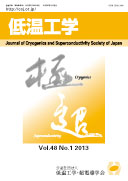巻号一覧

48 巻, 2 号
選択された号の論文の6件中1~6を表示しています
- |<
- <
- 1
- >
- >|
巻頭言
-
室町 英治2013 年48 巻2 号 p. 59
発行日: 2013/02/25
公開日: 2013/04/02
ジャーナル フリーPDF形式でダウンロード (659K)
解説
-
島本 進, 中嶋 秀夫, 高橋 良和2013 年48 巻2 号 p. 60-67
発行日: 2013/02/25
公開日: 2013/04/02
ジャーナル フリーCryogenic structuralmaterials are an essential element to fulfill the performanceof superconducting coils for fusion reactors. In this field, there was no specialized steel and mechanical properties data at 4 K until 30 years ago when the Japan Atomic Energy Agency (JAEA) started the development of the Tokomak fusion reactor. JAEA set a target of mechanical characteristics which could satisfy requirements for the coil structure at 4 K and equipped evaluation facilities at 4 K for tensile tests, fatigue tests and so on. At the same time, JAEA initiated collaboration with the steel industries in order to realize new cryogenic structural materials and carried out mechanical evaluation tests at 4 K on numerous samples which were supplied from the industries. There are two areas: a coil case and a conductor jacket for forced flow conductor. The former requires large forging products and thick hot-rolled plates for the coil case. The latter is influenced by heat treatment at approximately 650 °C and more than one-hundred hours to produce Nb3Sn superconducting material at the final stage. This is a unique issue for the jacket. Finally, both the case and the jacket material for construction of the ITER are now being supplied from the Japanese industries through JAEA. In addition, JAEA contributed to the standardization of these testing methods at 4 K in Japanese industrial standards (JIS). Furthermore, JAEA supported the establishment of a design code for the structure of superconducting coil for a fusion facility at the Japan Society of Mechanical Engineers (JSME). This paper describes the more than 30-year history of the development of cryogenic structural material.抄録全体を表示PDF形式でダウンロード (1502K) -
―需給の歴史と将来展望―阪東 寛, 坪井 勇一, 森 一彦2013 年48 巻2 号 p. 68-76
発行日: 2013/02/25
公開日: 2013/04/02
ジャーナル フリーA review is presented of how helium has been produced, supplied and consumed domestically in Japan and worldwide. In the majority of fields of helium consumption, recovery or recycling is not common due to cost issues. Historically, fields of end-use as well as production and supply of helium resources have been heavily affected by federal legislation in the United States. Considering the declining production and diminishing reservoir in the United States and rather unstable operation of resources in other countries in the future, at least domestically, development of low-cost helium recovery apparatuses and strategic promotion of helium recycling as performed for rare metals is crucial.抄録全体を表示PDF形式でダウンロード (1188K)
テーマ解説
-
―情報通信のイノベーションを目指して―寺井 弘高, 山下 太郞, 三木 茂人, 牧瀬 圭正, 王 鎮2013 年48 巻2 号 p. 77-82
発行日: 2013/02/25
公開日: 2013/04/02
ジャーナル フリーThe superconducting single-flux-quantum (SFQ) circuit is the ultimate energy-efficient digital circuit technology. The SFQ circuits are very promising for applications not only to huge systems such as supercomputers and/or high-end routers but also to the signal processing circuit operating with superconducting detectors. We introduce the recent progress in the SFQ circuit technology focusing on the application combined with superconducting single-photon detectors (SSPDs). The four-pixel SSPD array was successfully operated with the SFQ signal processing circuit in the 0.1 W Gifford McMahon refrigerator.抄録全体を表示PDF形式でダウンロード (1635K)
基礎講座
-
―有限要素法と境界要素法―植田 浩史, 石山 敦士2012 年48 巻2 号 p. 83-94
発行日: 2012/02/25
公開日: 2013/04/02
ジャーナル フリーAs methods of electromagnetic field analysis, the finite element method (FEM) and the boundary element method (BEM) have been widely used. The FEM is suitable for analysis of a complicated region which includes non-linear materials. On the other hand, the BEM is useful for analysis of infinitely extending fields. This time, the basics of FEM and BEM, and the boundary conditions of the electromagnetic field are explained.抄録全体を表示PDF形式でダウンロード (889K)
研究論文
-
吉村 卓哉, 土井 俊哉, 和泉 竹衛, 尾﨑 匠, 松本 明善, 北口 仁, 梶原 貴人, 嶋田 雄介, 波多 聰, 池田 賢一, 中島 ...2013 年48 巻2 号 p. 95-101
発行日: 2013/02/25
公開日: 2013/04/02
ジャーナル フリーWe fabricated Bi2Sr2Ca2Cu3O10 (Bi2223) thin films on SrTiO3 (100) substrates using a DC magnetron sputtering method. From X-ray diffraction measurements (θ-2θ and φ-scan), the as-grown film had a Bi2223 single phase and a biaxial crystal orientation. The critical temperature of the as-grown films was 72 K. For improving the crystallinity and inserting Pb into the films, the as-grown Bi2223 films were post-annealed at 840-866°C for 30 hours. The optimum post-annealing temperature was found to be around 848°C. The critical temperatures of the (Bi,Pb)2223 films post-annealed over 848°C exceeded 100 K and the critical current density of the film post-annealed at 848°C was 2.2 × 105 A/cm2 at 77 K in a self-field.抄録全体を表示PDF形式でダウンロード (1924K)
- |<
- <
- 1
- >
- >|